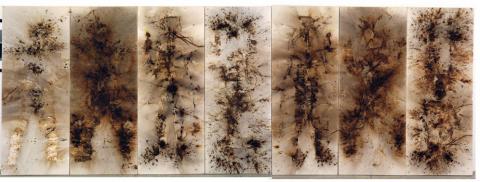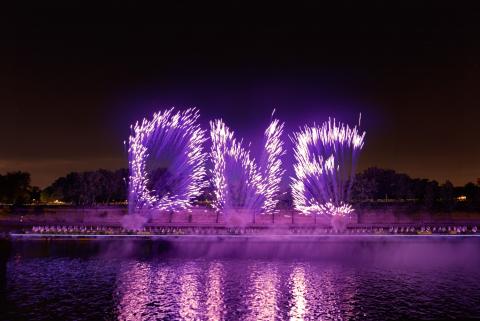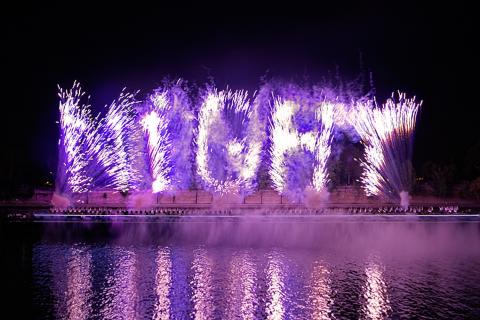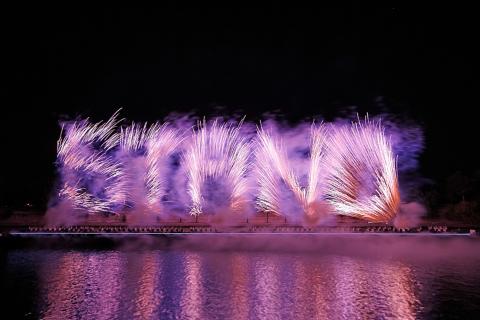CAI GUO QIANG: artist research, work analysis and critical reception
- artedelic
- Jul 26, 2015
- 7 min read
AIP1, Session 9

Cai Guo Qiang was born on 8 December 1957 in Guanchou, Fujian Province, China. His father was a calligrapher, and thus Cai was exposed early to Western literature (as his father was also a book collector) and traditional Chinese art forms. Cai grew up during the Cultural Revolution, led by Mao Zedong, and he was one of its avid supporters. The revolution involved burning books and other cultural items, and Cai often recalled his father burning his books and calligraphy works in the middle of the night (so as to not be caught by the neighbours and then punished) before he took refuge to a monastery.
Cai was interested in modern Western art forms and he studied stage design at the Shanghai Theatre Academy in 1981-1985. His understanding and sense for the theatre greatly influenced his later works.
In this session, I will be exploring Cai's works, by using examples and dividing them chronologically (early, "middle" and recent). I will also include the general critical reception of his art, as well as my own comments.
EARLY WORKS
Cai Guo Qiang was inspired by an interest in traditional Chinese culture and everyday aspects that defined it, often using myths and old stories as a basis for his later works. He was scholarly, and politically charged, though his political stance seems to change according to his works (or perhaps it depends on interpretation). Self-Portrait: A Subjugated Soul was originally made in 1985, but Cai later retouched it to express feelings of alienation and loneliness he felt when seperated from his homeland during a dark time in its history---the events of Tian'anmen Square, a brutal massacre.
As he approached his early 20s, he began experimenting with art-making techniques that harnessed the spontaneity of natural forces. His initial experiments involved blowing oil paint with an electric fan (similar to my work in Session 6---albeit with acrylic and a hair dryer), but in 1984 Cai started experimenting with gunpowder.
The gunpowder ignited directly on the canvas---resulting in a blackened and charred texture that felt like an explosion.
His gunpowder works, in my opinion, are very sombre and holds much agitated energy, as if the burns signal at an unexpressed thought underneath the surface. His use of gunpowder is also a gesture towards Chinese nationalism, as they were its inventors. However, he was initially hesitant about displaying these works in his home country, fearing that it could be interpreted as mockery.
"MIDDLE" WORKS
At some point, Cai started experimenting with installations and creating grand fireworks displays---a task that greatly benefits with his background in stage design. One of his most popular exhibitions in the "middle" years is INOPPORTUNE---a word that can be interpreted as "unfortn=unate".
Rightly so, the exhibition depicts various displays of pain and violence. The first installation shows an American car through various stages of a flip---the light rods are depictions of car bomb explosions. The second installation shows tigers (not taxidermied) with arrows sticking out of them, supposedly inspired by a Chinese story about a man who went hunting for tigers. The third installation depicts a pack of wolves involved in a vicious cycle---i.e. running headlong into a plexiglass wall, falling down and scampering back to the starting point, presumably to do it all over again. The interpretation of INOPPORTUNE lies both in the visible and invisible---each of them are beautifully crafted, spectacular and glamorous, and yet all of them depict pain. Looking at the car installation for the first time, you are immediately wowed, and then upon learning that it shows a car bombing, you feel horrible for admiring it. It seems inappropriate to love something so gruesome. It is terrible, yet fascinating.
This reflects on Cai's gunpowder works, and Mao Zedong's motto that describes the correlation between beauty and violence "destroy nothing, create nothing."
If there is beauty in destruction, it lies in its power, but Cai has turned that beauty unto aesthetics. The wolves installation contains a darker meaning---some say the wolves represent humans, who run headlong towards our own destruction, blind to an end (clear plexiglass) and yet, even after a destructive ordeal, are still ready to scamper back in line and do it all over again.
RECENT WORKS
Fireworks display for Nuit Blanche
In 2008, Cai was selected to be in charge of the opening and closing ceremony of the Beijing Olympics, greatly relying on pyrotechnics.
In 2013, Cai created "One Night Stand: An Explosion Event for Nuit Blanche", an annual art event in Paris. The show also relied heavily on pyrotechnics. First a firework series forming the words "One", "Night" and "Stand", then 50 couples having sex in tents (two men are in charge of shooting a 15-second fireworks show for every climax) followed by another fabulous display of pyrotechnics.
The Ninth Wave, 2014
"The Ninth Wave" involves 99 animals boarding a ship that was sailed down the Huangpu River in front of the bund, Shanghai. Its sail ends in the Power Station of Art, which houses the nest of the installations. But of course, no work of Cai Guo Qiang doesn't start with an incredible fireworks display. Inside the exhibition hall, among my favourite installations are "Silent Ink", an excavated hole filled with tons of gallons of chinese ink, and "Air of Heaven", in which three child-like dolls are perched on a swing, hung inside what used to be the factory's exhaust shaft.
The whole exhibition itself is a shout out against ecological problems. The fishing boat ride was inspired by the disposal of dead pigs down the Huangpu River by farmers.
It's also the opposite of Ivan Aivazovsky's work under the same name "The Ninth Wave", which depicts a group of humans on a ship, in a magnificently frightening sea gale. But whereas Aivazovsky's painting depicts men at the mercy of nature, Cai's works shows just the opposite---in reality it is nature that depends on the mercy of men, our modernisation and technology.

Ivan Aivazovsky's "The Ninth Wave"
"Silent Ink" creates a sombre, if not downright terrifying threat---a lake made of a synthetic ingredient surrounded by rubbles and ruins could be a warning against where the future of mankind is heading, a self-induced apocalypse. Its eerie quiet, at least before spectators come in, is a display of silent horror.
"Air of Heaven" is even more brutal, as three children playing in a factory shaft is a far cry from a natural, child-friendly setting. The fact that this shaft used to carry noxious fumes and poisonous smoke to the city is made even more gruesome by its ironic name. But perhaps, in a future where oxygen may be so scarce as the result of pollution, a factory shaft may be better than its alternatives. Even the pre-show pyrotechnics display fire flowers and blossoms, in gigantic sizes. Perhaps this is a nod towards modernity, whatever nature is left over is artificial, controlled, pedantic (great reference to Margaret Atwood's "The City Planners"!)
CRITICAL RECEPTION
Though Cai's works are indeed spectacular, this is perhaps their biggest weakness. Critics have gone to say that his works are too reminiscent of stage design and not "fine" arts. Jonathon Keats, a conceptual artist and critic, calls Cai Guo Qiang "good for China and bad for art", describing viewers as having been "seduced by the sculptural beauty"---insulting Cai's emphasis on pure aesthetics and less content.
He is also described as being "pragmatic" when it comes to politics and art, abiding them when it is practical to do so and ignoring them for the rest of the time.
Some critics found his works to be "empty". Peter Schjeldahl, another art critic, describes his works as "a product more of institutional programs then of plausible human interests and desires"---in short, Cai does what he does to impress people, and not to deliver a message or express himself. However, he defends Cai's ambiguous political views as "broadly philosophical"---detachedment for the sake of neutrality for learning.
Beth S. Gersh-Nesic, Director of the New York Art Exchange, adapts a completely different view---she described "Cai's attention to cross-cultural interaction reveals the truth of our era: that dichotomies can enhance our awareness of differences, but that differences in themselves may be only constructs/inventions of the mind." She also wishes that the tigers in INOPPORTUNE (2004) "magically come to life after visiting hours", and that his installation involving a broken boat in a rubble of porcelain hints at a "political critique through irony." (It is interesting to note that she begins every paragraph of the article with "I want to believe", as is the name of the exhibition, but also presents a hint of uncertainty---she WANTS to believe, but DOES she believe?)
To me, Cai Guo Qiang is a contradiction.
While I adore his powerful, agitated gunpowder drawings and the silent horror of The Ninth Wave exhibition, I cannot say that I am a fan of his works as a whole. Perhaps it is only his nature, as a stage design artist by training, but I feel like some of his works, such as INOPPORTUNE and "One Night Stand", are more concerned about aesthetics and not content, and whatever content there is comes from neutral cultural influences (myths and stories) or added later by his critics.
You could say that Cai's works are rather "pop art", clean works that draw on vague inspirations and rely heavily on cultural interpretations, but meant to, first and foremost, aesthetically please and wow the audience.
And it's not that I don't believe we are not alone in the universe, but his "Projects for Extraterrestials" sounds like a confused wandering between NASA operations and a Fourth of July fireworks bonanza, and "One Night Stand" sounds more like a publicity stunt.

"Projects for Extraterrestials", 1992
That said, I love the idea of gunpowder drawings, the idea of relinquishing control to a material so volatile and capricious is intriguing. "The Ninth Wave" holds a lonely resonation, a moody atmosphere that tickles your mind and leaves you feeling slightly pertrubed for the rest of the day.
Universal energies and inner energies, gunpowder and controlled makeshift animals, a neutral-esque interchanging and pragmatic political view---if Cai Guo Qiang loves contradictions, then a contradiction he shall be.

























Comments